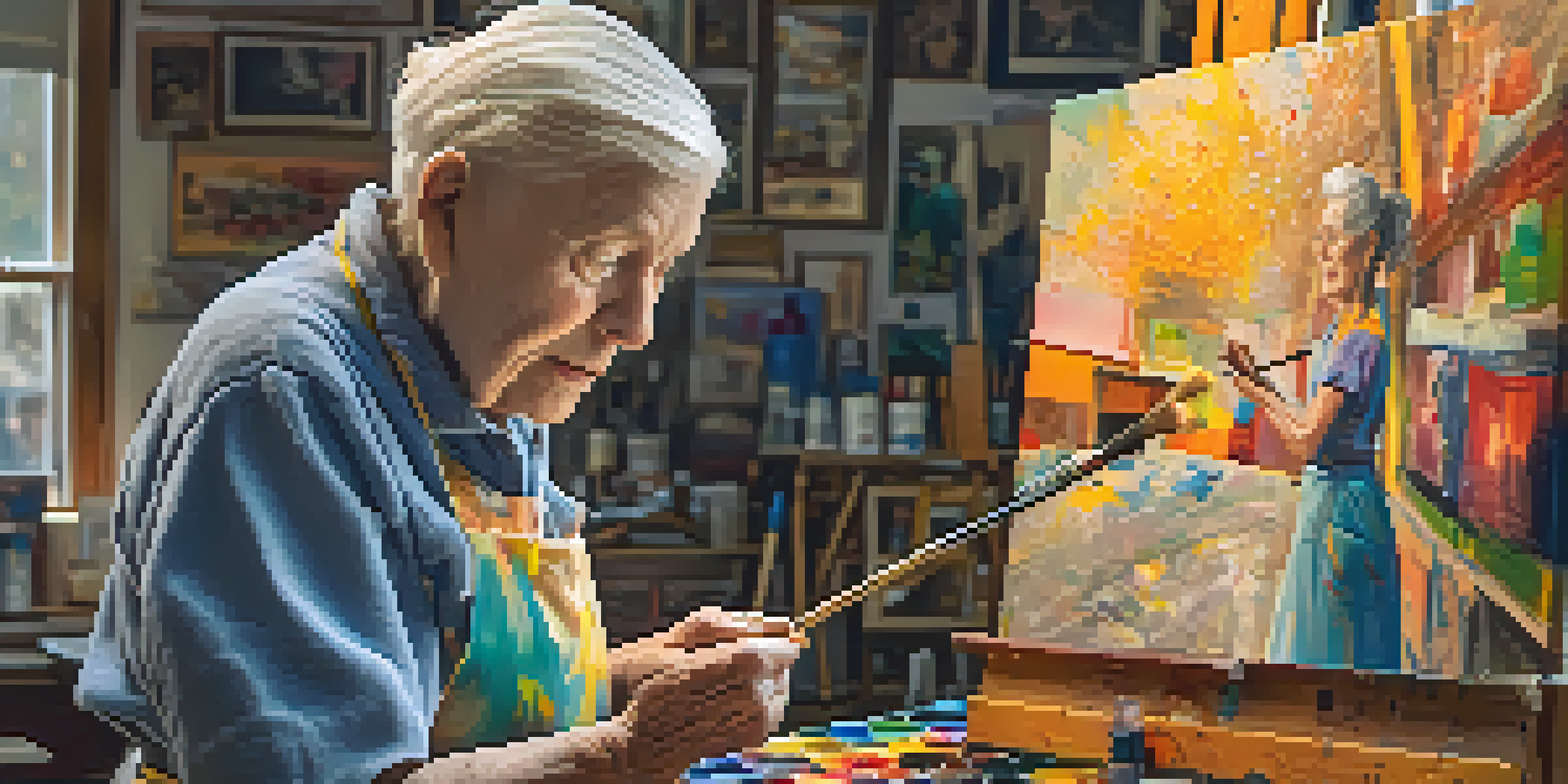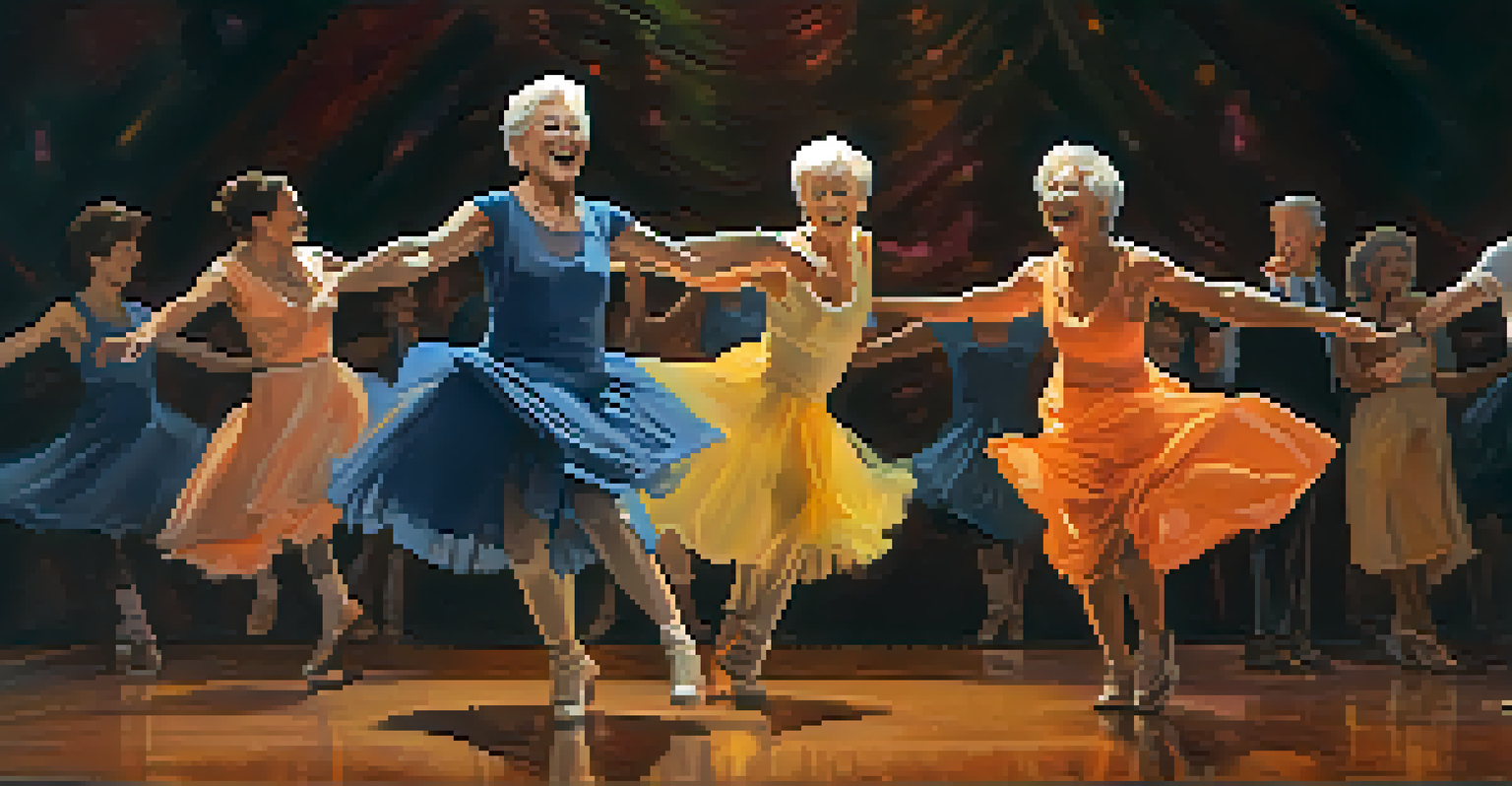How Art Can Challenge Stereotypes About Aging

Art as a Reflection of Diverse Aging Experiences
Art serves as a powerful mirror reflecting the myriad experiences of aging. From paintings to photography, artists capture the beauty and complexity of growing older. This representation can challenge the narrow views often held in society, showcasing aging as a rich tapestry rather than a declining phase of life.
Art is the most beautiful of all lies.
When we see older individuals depicted in art, it reminds us that they have lived vibrant lives filled with stories. For instance, portraits that highlight the wrinkles of a senior artist can symbolize wisdom and resilience, instead of frailty. This re-framing encourages us to appreciate the journey of aging rather than fear it.
Moreover, diverse forms of art, from street murals to digital media, broaden the conversation around aging. By engaging with these artworks, we can confront our biases and reconsider the stereotypes that often accompany discussions about older adults.
Storytelling Through the Lens of Aging
Storytelling is a universal form of art that can profoundly influence perceptions of aging. Through narratives, whether in literature, theater, or film, we can witness the rich inner lives of older characters. These stories humanize aging, revealing the emotions, challenges, and triumphs that come with it.

For example, films that focus on aging protagonists often explore themes of love, loss, and self-discovery, allowing audiences to connect deeply with these characters. This connection can break down the stereotypes that portray older people as out of touch or irrelevant. Instead, they emerge as complex individuals with relatable experiences.
Art Reflects Diverse Aging Experiences
Art captures the rich tapestry of aging, challenging societal stereotypes and showcasing the beauty of older lives.
Additionally, storytelling empowers older adults to share their own narratives. By encouraging them to express their thoughts and feelings, we foster a deeper understanding and appreciation of their life experiences, further challenging societal misconceptions.
The Role of Performance Art in Aging Perceptions
Performance art is another vibrant avenue through which aging stereotypes can be challenged. Through dance, theater, and spoken word, older artists can convey powerful messages about their lives and experiences. This active engagement defies the notion that aging is synonymous with passivity or decline.
Aging is not lost youth but a new stage of opportunity and strength.
For instance, dance troupes featuring older dancers showcase agility and creativity, proving that physical expression knows no age limit. When audiences witness these performances, they often leave with a renewed sense of respect for the capabilities of older individuals. This shift in perception can be incredibly impactful.
Moreover, performance art creates a space for dialogue about aging. By participating in or attending these events, people of all ages can engage in conversations that dismantle age-related stereotypes, fostering a sense of community and understanding.
Visual Art and the Aging Experience
Visual art, from paintings to sculptures, has a unique ability to challenge stereotypes about aging. Artists often use their medium to explore themes related to the aging process, highlighting both struggles and triumphs. By presenting aging in a nuanced way, visual art compels viewers to reconsider their preconceived notions.
Consider the work of artists who depict aging bodies with grace and dignity, shining a light on the beauty that comes with age. Such representations can evoke empathy and appreciation, encouraging society to celebrate rather than stigmatize older individuals. This approach invites us to see aging as a natural and beautiful part of life.
Storytelling Humanizes Aging
Through narratives in various forms, storytelling reveals the complex emotions and experiences of older individuals, breaking down misconceptions.
Additionally, community art projects involving older adults can further amplify their voices. When seniors contribute to public art, they not only express their perspectives but also engage with younger generations, fostering a shared understanding of aging.
The Impact of Art Therapy on Aging Perspectives
Art therapy is a powerful tool that can significantly reshape how individuals view aging. Through creative expression, older adults can explore their emotions, communicate their experiences, and find solace. This therapeutic approach helps to dismantle the stigma surrounding aging by focusing on the individual's strengths and narratives.
For example, workshops that encourage seniors to paint or write can reveal insights about their lives that they may not have expressed otherwise. This process not only boosts their self-esteem but also fosters a sense of community and connection with others. As they share their creations, stereotypes are challenged, and understanding deepens.
Furthermore, engaging in art therapy can improve mental health, reducing feelings of isolation and depression often associated with aging. When older adults feel valued and heard through their artistic expressions, it can lead to a broader societal shift in how we perceive and honor the aging population.
Community Engagement Through Art and Aging
Community art initiatives play a crucial role in reshaping perceptions about aging. By bringing together older adults and younger generations, these programs foster intergenerational dialogue and collaboration. Shared artistic experiences can break down barriers and highlight the commonalities that exist across age groups.
For instance, community mural projects that involve seniors and teenagers allow for storytelling and collaboration. This not only creates a beautiful piece of art but also cultivates mutual respect and understanding between different age groups. The resulting artwork becomes a testament to the value of every individual's contributions, regardless of age.
Community Art Fosters Understanding
Community art initiatives encourage intergenerational dialogue, highlighting the commonalities between age groups and reshaping perceptions of aging.
Additionally, community art events can showcase the talents of older artists, providing them with a platform to share their work. This visibility helps challenge stereotypes by demonstrating that creativity and passion continue to thrive well into later years.
Art as a Catalyst for Change in Aging Narratives
Art has the potential to be a powerful catalyst for change, especially when it comes to narratives surrounding aging. By challenging the dominant stereotypes through various art forms, we can create a shift in societal attitudes. Art encourages us to confront our beliefs and to see aging in a new light.
For example, public art campaigns that focus on positive aging can influence how communities perceive their older members. These initiatives often use humor, empathy, and relatability to convey messages that resonate across generations. By changing the narrative, we can foster a more inclusive society that values all ages.

Ultimately, embracing art as a tool for change allows us to celebrate the complexity of aging. We can inspire a movement that recognizes the contributions of older adults, encouraging a culture of respect and appreciation that transcends age.